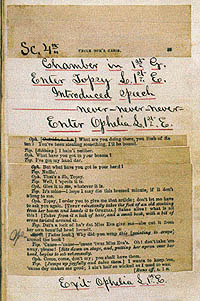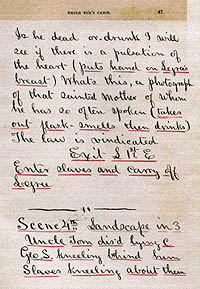

| Item fc1.11 in the Howard Family Collection at the Harry Ransom Humanities Research
Center is a bound promptbook made up of pages from the published text of Aiken's dramatization cut and
pasted on to new sheets of paper, along with new lines of dialogue and pieces of stage business
written in ink and underlined in red (as in the example above). It
is not dated, but was definitely created in the mid-1870s — probably, in fact, in the second half of 1876, in time to become the basis for the Howards' incredible run at New York City's Grand Opera House. A
handwritten note on the promptbook's first page describes it as "'Uncle Tom's Cabin' Perfected for
the Stage by G. C. Howard"; "Reconstructed by G. C. Howard" is how the Howards described it in a card published in The Clipper in January, 1878, offering to sell it to other theatrical companies. But whether you call it "perfected," "reconstructed" or (perhaps the most accurate term) unreconstructed, for students of American culture's various adaptations of Uncle Tom's Cabin,
it is among the most significant texts in this archive: the best access we have found
so far to the extraordinary process by which Stowe's anti-slavery novel became the "Tom Show," with
its nostalgia for what a 21
May 1876 ad refers to as the "old-time plantation . . . of pleasant memory." In five acts and 23 scenes (instead of Aiken's six and 26), the script cuts out about 15% of Aiken's play, including the first scene and almost all the scenes at Ophelia's in Vermont. (You can see a table comparing the two dramatizations by CLICKING HERE.) It also eliminates the characters of Gumption Cute and Mr. Wilson (many of Wilson's lines are given to Phineas). Other scenes are moved around or combined, mainly, it seems, to facilitate set changes. But this version probably took about the same amount of time to enact, because throughout the play are added scenes of "slaves" singing and dancing. These "slaves" were African American performers, who began to appear in increasingly large numbers on stage in Uncle Tom's Cabin in the early 1870s. As the promptbook reveals, they are never named and have no speaking parts. They typically appear at the beginning and/or end of scenes, to provide a kind of "black" sound track to moments like St. Clare's return to New Orleans, Eva's death or the auction scene. But the element that really distinguishes the "Tom Shows" from previous dramatizations is what became known in advertising as the play's "Plantation Scene." In this production that scene occurs in Act 4, Scene 3, and opens this way:  This "perfected" version contains a number of other revisions, including a new ending in which George Shelby kills Legree. You can read the whole script from the menu below. For comparison, Aiken's 1853 text is available HERE -- but you can also identify the passages that Howard takes directly from Aiken's original version by the presence in the promptbook text of italics and SMALL CAPITAL LETTERS, the typographical features of that text as published by Samuel French. The electronic text of the promptbook also includes .jpeg images of all the handwritten stage directions involving "Slaves." In some of these you'll notice another set of handwritten directions (in pencil this time): sometime after this "perfected" text was established, it was revised again to shorten the play; for example, the conversation between Legree and Cassy about his mother was eliminated. Those later changes, however, are not captured by the text available here. The George C. Howard and Family Collection Harry Ransom Humanities Research Center at the University of Texas at Austin  |
 THIS PAGE FROM THE RANSOM CENTER All rights reservered.  |
|
